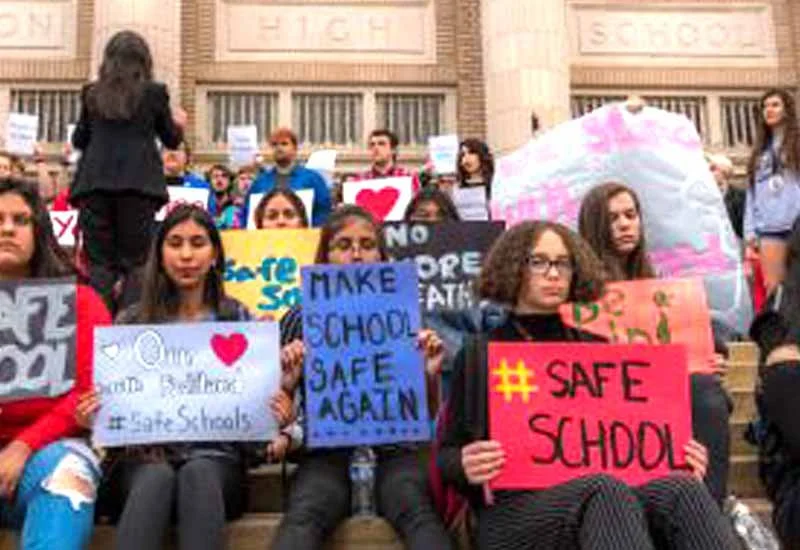After Apalachee: 9 Tips for Parents After a School Shooting
Pamela Cantor, M.D. offers ideas on how to encourage youth to talk about gun violence and what they can do about it.
Again. It’s happened again. The shooting at Apalachee High School in Georgia is a horrifying reminder that safety from gun violence is not guaranteed in this country, not for our children, not for their teachers. Two teachers and two students have been killed, allegedly by a 14 year-old schoolmate who is now in custody.
There is no promise of safety that can be made in the United States today—not after Apalachee High School; Uvalde, Texas; Parkland, Fla.; Newtown, Conn.… the list of horror and heartbreak goes on. Today, no parent can guarantee this safety, and no child can feel truly safe. School shootings have become so commonplace, many young people are desensitized to the threat and accept it as a given. That is shocking but that doesn’t mean they are immune from the effects of fear or that we should stop doing all we can to protect them from this danger to their health and learning.
Gun Violence in Schools on the Rise

Since the Columbine High School rampage in 1999, there have been shootings at more than 400 schools, 32 this year alone. During this period, more than 380,000 children have been exposed to gun violence in their schools, which is by itself deeply traumatizing. Millions more across the country have had their sense of safety shaken to the core.
Safety and Learning
The connection between safety and learning is fundamental. We may not be able to see how fear is interfering with learning, but without a sense of safety and belonging, a child’s ability to focus, concentrate, persist, and even remember what has already been learned gets interrupted. Their ability to fulfill their potential is derailed. There is a biological reason for that.
Stress and the Brain
When humans are under stress, when we feel unsafe, the hormone cortisol floods our bodies. In small doses, cortisol can be helpful. It produces that familiar feeling of fight, flight or freeze, and helps us prepare for an exam or a performance or get out of the way of a falling object. In large amounts, however, when stress is unrelenting and when it is unbuffered by the presence of a trusted adult, cortisol becomes toxic. It weakens our immune and health systems disrupting the development of the brain’s limbic system which is key to attention, memory, learning and the regulation of our emotions.
Fortunately, this is not the end of the story. The hormone oxytocin is also part of the human stress response, and it is more powerful at the level of the cell than cortisol. Oxytocin produces feelings of trust, love and safety, but that’s not all. It protects against the damage done by overwhelming stress, it heals, and it produces resilience to future stress.

Remember that children can derive their sense of safety from the adults in their lives, especially when they are in very stressful situations. Oxytocin helps us understand that there is a biological basis for that feeling. This means that the most powerful tool adults have to manage stress and to help our young people manage stress is the human relationship. It is human connection and the ability to communicate meaningfully about events like this one. Relationships that are strong and trustful release oxytocin, and oxytocin can restore a child’s sense of safety and well-being.
It may be difficult today for adults to convince some young people that they are going to be safe in school. Nonetheless, there are things that parents and teachers must do to try to enable young people to talk about what this reality in their lives means to them.
9 Tips for Talking to Young People
Here are nine tips for adults to talk to young people in the aftermath of school shootings:
- **Initiate a conversation:** Don’t wait for your kids to bring up shootings. Ask what your children are being told and most importantly what they are feeling and listen carefully so you can respond to their concerns, misconceptions, and fears truthfully. Adjust your answers depending on the age of the child. Assure them that you will create ongoing opportunities to talk and connect; then do so often.
- **Keep calm and keep it real:** Young people read the faces and emotions of adults well. Before you talk to a child or teenager, prepare yourself so that you can be as calm, collected, confident, convincing and consistent as you can be. Most of all, be truthful and authentic.
- **Limit exposure to disturbing media:** Regulate children’s exposure to the frightening images and sounds available on all forms of media, including social media, especially those of kids fleeing school buildings, and distraught and angry parents.
- **Keep routines in place:** Routines are reassuring to young people, but don’t force them to go to school if they are terrified. If your child asks if this could happen at their school, you can tell them that while gun violence is not going away, there are many people trying to solve it. Do let your child know the person responsible for the shooting cannot hurt anyone ever again.
- **Keep an eye out:** Notice if your child is having trouble eating or sleeping, is complaining of head and stomach aches, or is having difficulty concentrating. These could be signs of something more serious, like an emerging depression or post-traumatic stress syndrome. Young children may regress and cling; teens may be more defiant than usual. If symptoms of extreme stress persist after a few weeks, seek medical attention. Note: Adolescents who were present at Apalachee High School knew those directly affected; those who have experienced similar incidents will need more support in the days and weeks ahead.
- **Talk about your own worries:** Do say that you are worried about the shootings, but at the same time convey why you believe they and we will be OK again. Tell your child that there are adults trying to make it harder for dangerous people to buy the guns used in the school shootings but that it won’t happen right away. If they know of any young person who could be thinking of harming others or themselves, encourage them to talk with you or an adult at their school whom they trust. Reassure them that you will help them to know what to do with this information.
- **Ask the kids:** Our youth are on the front lines of gun violence in their schools. Ask them what ideas they have to mitigate the threat. Explore ways to empower them to identify real risks within their communities to help prevent another tragedy.
- **Do something:** Share information on how to help and support the students, teachers and families in Georgia. Join other parents and community members to talk with school leaders about how they’re handling security now. Write and call your elected representatives to ask them what they are doing to make schools safe from mass shootings.
- **Take care of yourself so you can care for others:** Remember, you are one of the most important adults in the life of your child. Taking care of yourself, including exercising, eating and sleeping well, and using reflective practices, such as journaling and meditation, will help you care for others.
Did you notice that all nine tips revolve around one important biological fact? The human relationship has the power to relieve stress, promote resilience, and restore a young person’s sense of safety, which is fundamental to learning. This fact is what all adults should be guided by in their actions with young people today.
Pamela Cantor, M.D., is a child and adolescent psychiatrist and a trusted voice on the science of learning and human development. She is the Founder and CEO of The Human Potential L.A.B., whose mission is to leverage the latest scientific knowledge and technologies to transform what people understand and what institutions do to unlock human potential in each and every individual.
Dr. Cantor is a Senior Scientist at the Institute for Applied Research in Youth Development at Tufts University, and an author of Whole-Child Development, Learning and Thriving: A Dynamic Systems Approach (Cambridge University Press) and The Science of Learning and Development (Routledge). She founded and led the nonprofit organization Turnaround for Children (now the Center for Whole-Child Education at Arizona State University), serving as President and CEO from 2002 to 2018.


